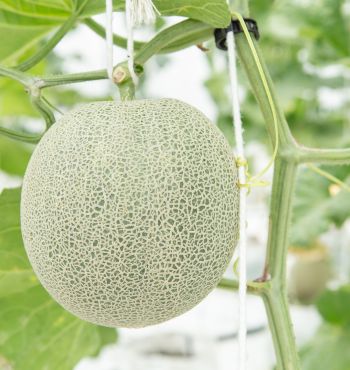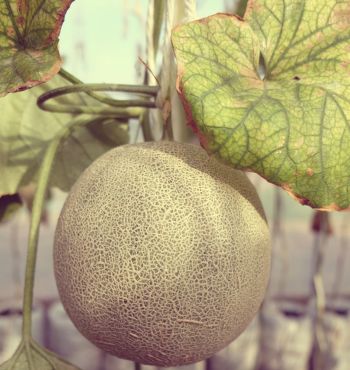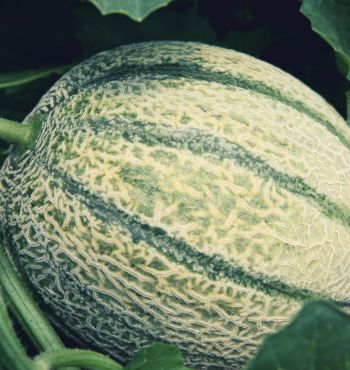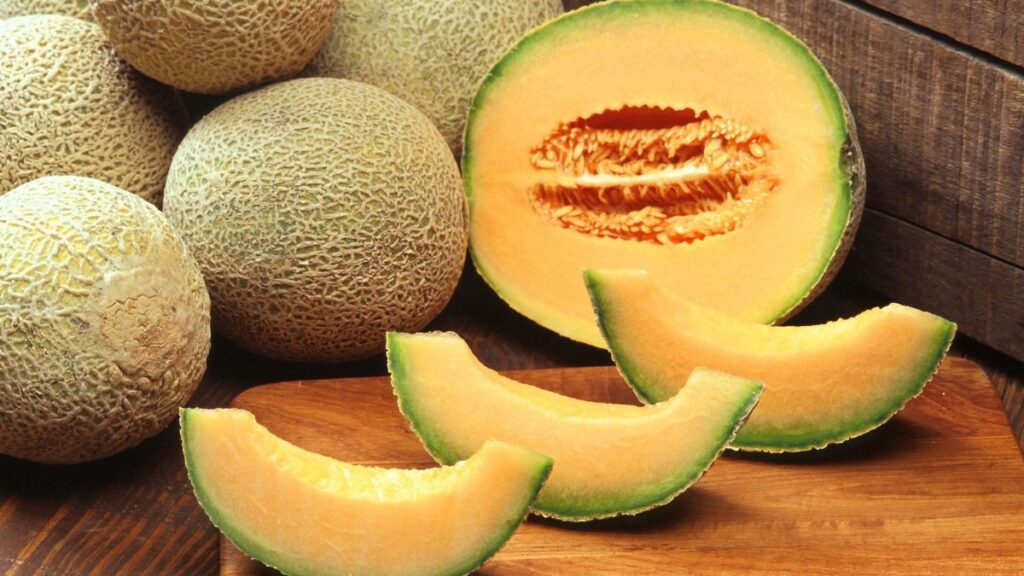Companion Planting With Cantaloupe involves planting beneficial plants alongside to enhance growth and deter pests. Cantaloupes can thrive when planted with corn, beans, and sunflowers due to their symbiotic relationships, while avoiding planting them with potatoes or cucumbers as they can compete for nutrients.
Additionally, marigolds and nasturtiums can be effective companions for cantaloupes as they repel pests with their strong scents. These plants can create a balanced and harmonious environment, providing shade, support, and natural pest control for the cantaloupe plants. By utilizing companion planting techniques, gardeners can maximize the success of their cantaloupe crops while minimizing the need for chemical interventions.
The Benefits Of companion planting with cantaloupe
Companion planting is a gardening technique that involves growing different plants together to maximize their potential. When it comes to cantaloupe, companion planting offers a wide range of benefits that can improve the health and yield of your crop. In this article, we will explore three key benefits of companion planting with cantaloupe: enhanced soil fertility, pest control, and improved pollination.
Enhanced Soil Fertility
By choosing the right companion plants, you can improve the fertility of the soil in which your cantaloupes are grown. Certain plants have the ability to fix nitrogen in the soil, which is an essential nutrient for strong plant growth. For example, planting legumes like beans or peas alongside cantaloupes can provide a natural source of nitrogen, replenishing the soil and promoting healthy fruit development.
Pest Control
Companion planting can help deter pests and reduce the need for chemical pesticides. Some plants act as natural repellents, protecting cantaloupes from common pests like aphids and cucumber beetles. Herbs like basil and marigolds have strong scents that repel insects, making them excellent companions for cantaloupe plants. Additionally, planting certain flowers like nasturtiums can attract beneficial insects like ladybugs, which feed on harmful pests.
Improved Pollination
Pollination is crucial for fruit set in cantaloupes. Companion planting can attract pollinators such as bees and butterflies, increasing the chances of successful pollination and higher fruit yields. Flowers like zinnias, sunflowers, and lavender are not only beautiful additions to your garden but also serve as valuable sources of nectar, attracting pollinators that will visit your cantaloupe plants as well.

Introduction To Cantaloupe As A Companion Plant
Discover the benefits of companion planting with cantaloupe, a practice that enhances the growth and health of neighboring plants. Explore how this technique promotes successful gardening and maximizes overall plant productivity.
Overview Of Cantaloupe
Cantaloupe, also known as muskmelon or rockmelon, is a delicious and nutritious fruit that belongs to the Cucurbitaceae family. With its sweet and refreshing taste, cantaloupe is a favorite summertime treat for many. This tropical fruit is not only a delight for our taste buds but also a valuable addition to our gardens as a companion plant.
Why Cantaloupe Works Well With Other Plants
Companion planting is a gardening technique that involves growing different plants together to benefit each other in various ways. Cantaloupe, with its sprawling vines and beautiful foliage, can offer several advantages when grown alongside other plants in your garden.
- Cantaloupe acts as a natural ground cover, shading the soil and reducing weed growth.
- The large leaves of cantaloupe provide shade and act as a living mulch, helping to retain moisture in the soil and prevent it from drying out.
- By interplanting cantaloupe with other crops, you can maximize the use of space in your garden.
- The attractive flowers of cantaloupe can attract pollinators like bees and butterflies, which are essential for the successful growth and fruiting of many plants.
- Cantaloupe emits certain volatile compounds that repel pests, thereby protecting neighboring plants from insect damage.
Complementary Plant Options
When choosing companion plants for cantaloupe, it’s important to select crops that have similar growth requirements and complement each other’s needs. By considering the following options, you can create a harmonious garden ecosystem that will result in healthier plants and increased yields.
| Plant | Companion Benefits |
| Beans | Fix nitrogen in the soil, improving fertility |
| Corn | Provides vertical support for cantaloupe vines |
| Nasturtiums | Repel aphids and other pests |
| Basil | Enhances the flavor of cantaloupe and repels mosquitos |
| Marigolds | Deter nematodes and attract beneficial insects |
By strategically planting cantaloupe alongside these complementary crops, you can create a diverse and mutually beneficial garden ecosystem where plants support and protect each other, leading to a healthier and more productive harvest.

Selecting The Right Companion Plants
When it comes to companion planting with cantaloupe, selecting the right companions is key to a successful and productive garden. Companion plants are those that provide benefits to each other when grown together. They can help deter pests, attract beneficial insects, improve soil fertility, and even enhance the flavor and growth of the main crop. In this article, we will explore the best companion plants for cantaloupe and the ones to avoid to ensure your melon patch thrives.
Plants To Avoid
If you want your cantaloupe plants to thrive, it’s important to know which plants to avoid planting alongside them. The following plants can have negative effects on cantaloupe growth and should be kept at a distance:
- Beans: Beans and other legumes can suppress the growth of cantaloupe due to their nitrogen-fixing abilities, which can lead to an imbalance in soil nutrients.
- Brassicas: Brassicas like cabbage, broccoli, and cauliflower can attract pests that also feed on cantaloupe, such as aphids and cabbage loopers.
- Potatoes: Potatoes can compete with cantaloupe for sunlight, water, and nutrients, potentially stunting the growth of both plants.
Best Companion Plants For Cantaloupe
Now that we know which plants to avoid, let’s explore the best companion plants for cantaloupe:
| Companion Plant | Benefits |
| Nasturtiums | These vibrant flowers attract pollinators and repel aphids, making them a great companion for cantaloupe plants. |
| Basil | Basil helps deter pests such as thrips and mosquitoes, and its aromatic properties may even enhance the flavor of cantaloupe. |
| Marigolds | Marigolds are known for their pest-repellent properties, particularly against nematodes, which can harm cantaloupe root systems. |
| Corn | Corn provides natural shade for cantaloupe vines while attracting beneficial insects like ladybugs that prey on common melon pests. |
Factors To Consider
When selecting companion plants for your cantaloupe, there are a few factors to consider:
- Plant Growth: Choose companion plants that have similar growth requirements to cantaloupe, ensuring they won’t compete for resources.
- Pest Control: Look for plants with pest-repelling properties that can help protect your cantaloupe from common pests.
- Attracting Beneficial Insects: Select companion plants that attract beneficial insects like pollinators and predators of harmful pests.
- Fragrance: Consider plants with fragrant leaves or flowers that can help mask the scent of cantaloupe from pests like cucumber beetles.
By carefully selecting the right companion plants for your cantaloupe, you can create a harmonious and productive garden that maximizes the growth and flavor of your melons.

Improving Soil Fertility
Companion planting with cantaloupe is a smart way to improve soil fertility. This technique helps enhance nutrient availability, control pests, and promote healthy growth for both cantaloupes and neighboring plants.
Improving Soil Fertility When it comes to growing healthy and productive cantaloupe plants, improving soil fertility is crucial. By implementing companion planting techniques, you can boost the nutrient content of your soil, resulting in larger and sweeter melons. In this section, we will explore three effective methods for enhancing soil fertility: nitrogen-fixing plants, dynamic accumulators, and planting cover crops. Nitrogen-Fixing Plants One of the key elements necessary for plant growth is nitrogen.
Nitrogen-fixing plants, such as legumes, have the remarkable ability to convert atmospheric nitrogen into a usable form for other plants. By incorporating these plants into your cantaloupe garden, you can naturally enrich the soil with nitrogen. This process enhances the overall health and productivity of your cantaloupe plants. Dynamic Accumulators Dynamic accumulators are plants that have deep root systems, enabling them to mine nutrients from deeper soil layers and bring them to the surface.
These nutrients are then made available to nearby plants, including cantaloupes. By strategically planting dynamic accumulators, like comfrey or daikon radishes, near your cantaloupe plants, you can improve soil fertility by increasing nutrient availability and enhancing overall plant growth. Planting Cover Crops Another effective way to improve soil fertility is by planting cover crops. Cover crops, such as clover or buckwheat, not only protect the soil from erosion but also serve as living mulches that suppress weeds.
These crops improve soil structure and increase organic matter content, leading to better water retention and nutrient availability for plants. Prior to planting your cantaloupe seeds, consider growing cover crops during the off-season to rejuvenate the soil and maximize its fertility.
Controlling Garden Pests
Control garden pests effectively by utilizing companion planting with cantaloupe. This method helps ward off unwanted insects and promotes the healthy growth of your garden.
Repelling Insects With Companion Plants
Controlling garden pests is an essential aspect of maintaining a healthy and productive garden. One effective method of pest control is companion planting with cantaloupe. By strategically planting certain companion plants alongside your cantaloupe crops, you can repel pests and ensure a bountiful harvest. These companion plants release specific aromas and natural substances that act as natural insect repellents, keeping the pesky bugs away from your precious cantaloupes.
Here are some companion plants that can help you repel insects:
- Nasturtiums: These vibrant flowers not only add beauty to your garden, but they also repel aphids, whiteflies, and squash bugs. Plant them near your cantaloupe vines to deter these harmful insects.
- Marigolds: These colorful flowers are well-known for their pest-repellent properties. Planting them alongside your cantaloupes can repel nematodes, aphids, and cucumber beetles.
- Basil: Not only does basil enhance the flavor of many dishes, but it also repels mosquitoes and flies. By planting basil near your cantaloupes, you can protect them from these annoying pests.
Attracting Beneficial Insects
In addition to repelling harmful insects, companion planting can also help attract beneficial insects to your garden. These helpful insects prey on garden pests, acting as natural pest control agents. By incorporating plants that attract beneficial insects, you can create an ecosystem that promotes a balance between pests and predators.
Here are some companion plants that can attract beneficial insects:
- Sunflowers: These tall and vibrant flowers are a favorite among beneficial insects, such as ladybugs and lacewings. Planting sunflowers near your cantaloupes can attract these insects, which feed on aphids and other harmful pests.
- Dill: The delicate yellow flowers of dill are known to attract beneficial insects like hoverflies and parasitic wasps. These insects help control aphid populations, ensuring your cantaloupes remain pest-free.
- Alyssum: This low-growing flower releases a sweet fragrance that attracts hoverflies, lacewings, and parasitic wasps. Planted near your cantaloupes, alyssum can help keep pests in check.
Natural Pest Deterrents
In addition to companion plants, there are other natural pest deterrents that you can incorporate into your cantaloupe garden. These methods rely on natural substances to repel pests, avoiding the use of chemical pesticides.
Here are some natural pest deterrents you can try:
- Garlic: Garlic acts as a potent natural insect repellent. Planting garlic cloves near your cantaloupes can repel aphids, flea beetles, and other common garden pests.
- Onions: Similar to garlic, onions release a strong odor that repels many pests. By planting onions alongside your cantaloupes, you can deter aphids, thrips, and onion flies.
- Mint: Mint plants emit a powerful aroma that repels ants, moths, and mice. Planting mint near your cantaloupes can help deter these pests from damaging your crops.
Promoting Pollination
One of the key factors that can greatly enhance the success of growing cantaloupe is effective pollination. When cantaloupe plants are adequately pollinated, it leads to better fruit set and consequently, a bountiful harvest. Companion planting with cantaloupe not only serves as a natural and eco-friendly method of managing pests but also plays a crucial role in promoting pollination. In this article, we will explore the various ways you can use companion plants to attract pollinators, create a pollinator-friendly garden, and enhance cantaloupe fruit set.

Attracting Pollinators With Companion Plants
Companion plants that produce abundant pollen and nectar can help attract pollinators to your garden. Bees, butterflies, and other beneficial insects are essential for pollinating cantaloupe flowers, as they transfer pollen from the male flowers to the female flowers. Including companion plants with bright and fragrant flowers such as marigolds, lavender, and sunflowers can act as beacons for pollinators. These plants not only provide a source of food for pollinators but also offer attractive landing platforms for them to rest and take flight again.
Creating A Pollinator-friendly Garden
In addition to incorporating companion plants, creating a pollinator-friendly garden environment will further encourage visitation by beneficial insects. Providing a diverse range of flowering plants that bloom at different times throughout the growing season ensures a consistent food source for pollinators. Consider planting native wildflowers, herbs like basil and dill, and other pollinator-friendly plants. Ensure your garden provides suitable shelter and water sources, such as small ponds or birdbaths. By mimicking a natural habitat, you can transform your garden into a haven for pollinators.
Enhancing Cantaloupe Fruit Set
When it comes to cantaloupe fruit set, effective pollination is key. This can be further optimized by choosing companion plants that not only attract pollinators but also provide physical support for cantaloupe vines. For instance, tall plants like corn or trellis-supported plants such as cucumbers and beans can serve as natural trellises for cantaloupe vines to climb upon. This not only maximizes the use of vertical space but also ensures better air circulation and sunlight exposure which can promote healthier plant growth and ultimately, enhance fruit set.
In conclusion, companion planting with cantaloupe offers a holistic approach to promote pollination in your garden. By attracting pollinators with companion plants, creating a pollinator-friendly garden environment, and enhancing cantaloupe fruit set through strategic planting, you can significantly increase the likelihood of a successful harvest and enjoy the sweet rewards of homegrown cantaloupes.
Companion Planting Layout And Tips
Discover effective companion planting tips for growing cantaloupe. Learn about the ideal layouts and combinations to maximize the health and yield of your cantaloupe plants.
Arranging Your Garden Beds
When it comes to companion planting with cantaloupe, arranging your garden beds properly is crucial for a successful harvest. Cantaloupes require full sun and ample spacing to thrive, so it’s important to plan your layout accordingly. Here are a few tips to help you get started:
- Choose a sunny location: Cantaloupes love sunlight, so select a spot in your garden that receives at least 6-8 hours of direct sunlight each day.
- Provide ample space: Each cantaloupe plant needs plenty of room to spread out. Space your cantaloupe plants at least 3-4 feet apart to ensure they have enough space to grow and produce healthy fruits.
- Elevate your plants: Consider using raised beds or mounds to improve drainage and prevent waterlogged soil. This will help prevent diseases and promote better root development.
Intercropping Techniques
Intercropping with compatible plants can benefit your cantaloupe plants in numerous ways. By strategically planting certain vegetables and herbs alongside your cantaloupes, you can help deter pests, improve pollination, and enhance the overall health of your garden. Here are a few intercropping techniques to consider:
- Plant with corn: Corn acts as a natural trellis for cantaloupe vines, providing them with a support system to climb on. In return, cantaloupes help shade the soil around the corn, conserving moisture and suppressing weed growth. It’s a win-win combination!
- Pair with marigolds: Planting marigolds around your cantaloupe bed can help repel pests like aphids and nematodes. The strong scent of marigolds acts as a natural deterrent, keeping these garden invaders away from your precious cantaloupes.
- Combine with beans: Beans are known to fix nitrogen in the soil, which can benefit cantaloupes that are heavy feeders. Planting beans next to your cantaloupes helps enrich the soil and improve overall plant health.
Additional Tips For Successful Companion Planting
To maximize the benefits of companion planting with cantaloupe, here are a few additional tips to keep in mind:
- Rotate plantings: Avoid planting cantaloupes or their companion plants in the same spot year after year. Rotating your crops helps prevent the buildup of pests and diseases in the soil and promotes healthier growth.
- Consider vertical gardening: Growing cantaloupes vertically on trellises or using other vertical gardening techniques can save space, improve airflow, and make it easier to manage your garden.
- Maintain proper soil moisture: Cantaloupes need consistent moisture, especially during the fruiting stage. Use mulch to retain moisture, water the plants at the base, and avoid overwatering to prevent disease issues.
Remember, companion planting is not an exact science, and it may require some trial and error to find the best combinations for your specific garden. By implementing these layout and intercropping techniques, along with additional tips, you’ll be well on your way to a bountiful cantaloupe harvest. So get creative, experiment, and enjoy the benefits of companion planting with cantaloupes!
Maintaining A Healthy Cantaloupe Companion Garden
Discover the secrets of successful companion planting with cantaloupe to maintain a healthy and thriving garden. Learn how to strategically pair cantaloupe with compatible plants for optimal growth and pest control. Improve your gardening skills and reap the rewards of a bountiful harvest.
Maintaining a Healthy Cantaloupe Companion Garden Watering and Irrigation When it comes to maintaining a healthy cantaloupe companion garden, proper watering and irrigation are crucial. Cantaloupes require about 1-2 inches of water per week, so it is important to ensure they are properly hydrated. To accomplish this, consider the following watering and irrigation practices:
- Regularly monitor the soil moisture levels using a soil moisture meter.
- Water the cantaloupes deeply, ensuring the water reaches the roots.
- Avoid overwatering, as it can lead to root rot and other diseases.
- Mulch the garden beds to retain moisture and reduce water evaporation.
- Water in the early morning or late evening to minimize water loss due to evaporation.
Weed Control Weeds can compete with cantaloupe plants for nutrients and water, hindering their growth and development.
Implementing effective weed control strategies is essential for maintaining a healthy cantaloupe companion garden.
Consider the following tips
- Regularly inspect the garden beds and remove any weeds manually.
- Apply a layer of organic mulch, such as straw, around the cantaloupe plants to suppress weed growth.
- Consider using black plastic mulch to prevent weeds from germinating and growing.
- Avoid using chemical herbicides, as they can be harmful to the cantaloupe plants and the environment.
Regular Monitoring and Maintenance Regular monitoring and maintenance are key to ensuring the continued health and successful growth of your cantaloupe companion garden.
Here are some important tasks to consider:
- Regularly check the plants for signs of pests or diseases.
- Remove any diseased or damaged leaves or fruits promptly.
- Provide support, such as trellises or cages, to help the cantaloupe vines grow vertically.
- Trim off any excess foliage that may provide shade and hinder fruit ripening.
- Monitor for signs of nutrient deficiencies and address them promptly with organic fertilizers or soil amendments.
By implementing these practices and maintaining a healthy cantaloupe companion garden, you can maximize the yield of your cantaloupes and promote the overall health of your garden ecosystem. Prioritize proper watering and irrigation, implement effective weed control, and engage in regular monitoring and maintenance for a fruitful and thriving cantaloupe garden.
Assessing The Success Of Companion Planting With Cantaloupe
Companion planting with cantaloupe shows promising results in terms of improved growth and productivity. By strategically planting compatible crops alongside cantaloupes, gardeners can optimize soil health, deter pests, and promote a well-balanced ecosystem, leading to successful harvests.
When it comes to growing cantaloupe, companion planting can be a helpful strateg{y}. By pairing your cantaloupe plants with compatible companion plants, you can enhance their growth, deter pests, and promote overall plant health. But how do you assess the success of companion planting when it comes to your cantaloupe crop? In this section, we will explore two important aspects to consider: observing plant growth and health, and assessing pest and disease incidence. Let’s delve into the details
Observing Plant Growth And Health
One of the key indicators of successful companion planting with cantaloupe is the growth and health of your plants. Observe how your cantaloupe plants are reacting to their companion plants. Look for signs of improved growth, such as lusher foliage, stronger stems, and increased fruit production. Additionally, pay attention to any changes in plant health, such as a reduction in pest damage or disease incidence. These observations will provide valuable insights into the effectiveness of your companion planting strategy.
Assessing Pest And Disease Incidence
Pests and diseases can wreak havoc on your cantaloupe crop. However, companion planting can help deter pest infestations and reduce disease incidence. Keep a close eye on your cantaloupe plants and their companion plants to assess the effectiveness of this strategy. Look for signs of pest damage or disease, such as chewed leaves, wilting, or discoloration. Compare the incidence and severity of these issues in your companion planting beds to those without companion plants. This comparison will give you an idea of how well your companion plants are protecting your cantaloupe.
Remember, different companion plants have varying degrees of effectiveness against pests and diseases. It’s important to monitor and evaluate the specific results for each combination of cantaloupe and companion plants you have chosen.
To help you keep track of your observations and assessments, here’s a simple table:
| Companion Plant | Observed Improvements | Reduced Pest/Disease Incidence |
| Marigold | Lusher foliage and increased fruit production | Reduction in aphid infestations |
| Nasturtium | Stronger stems and improved overall plant health | Deterrent effect on squash bugs |
| Basil | Enhanced aroma and flavor of cantaloupe | Resistance to downy mildew |
By documenting your observations in a table like this, you can easily track the success of your companion planting strategy over time and make informed decisions for future plantings.
Overall, assessing the success of companion planting with cantaloupe involves monitoring plant growth and health, as well as evaluating pest and disease incidence. With careful observation and record-keeping, you can determine the effectiveness of your companion planting strategy and make adjustments as needed to optimize your cantaloupe yield.
FAQ for Companion Planting With Cantaloupe
What Can You Not Plant With Cantaloupe?
Avoid planting potatoes and melons together, as they can compete for resources and increase the risk of disease.
What Not To Plant Next To Melons?
Avoid planting cucumbers, squash, pumpkins, and other members of the cucurbit family alongside melons. These plants can cross-pollinate and negatively impact the flavor and quality of melons.
Where Should Cantaloupe Be Planted In The Garden?
Cantaloupes thrive in warm climates, so plant them in a sunny spot with well-draining soil. Ensure the garden receives at least 6-8 hours of sunlight daily. Space the plants about 2-3 feet apart and provide support for the vines to grow on.
Can Cantaloupe And Zucchini Be Planted Together?
Yes, cantaloupe and zucchini can be planted together. They have similar growth requirements and can complement each other in terms of pollination and space utilization. Plant cantaloupes and zucchinis about 3 feet apart to ensure they have enough space to grow properly.
Conclusion
Incorporating companion plants in your cantaloupe garden can have numerous benefits. Not only can it improve pollination and deter pests, but it can also enhance the overall health and productivity of your plants. By strategically selecting compatible plants and understanding their interactions, you can create a thriving and harmonious garden ecosystem.
So, give companion planting a try and watch your cantaloupes thrive alongside their beneficial companions. Happy gardening!






